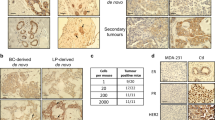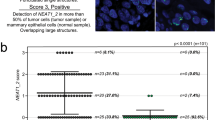Abstract
Only a few critical oncogenes have been identified in the more commonly occurring cases of sporadic breast cancer. We provide evidence that EN2 is ectopically expressed in a subset of human breast cancer and may have a causal role in mammary tumorigenesis. Nontumorigenic mammary cell lines engineered to ectopically express En-2 have a marked reduction in their cycling time, lose cell contact inhibition, become sensitive to 17-AAG treatment, fail to differentiate when exposed to lactogenic hormones and induce mammary tumors when transplanted into cleared mammary glands of syngeneic hosts. RNA interference studies suggest that EN2 expression is required for the maintenance of the transformed phenotype of a human breast tumor cell line.
This is a preview of subscription content, access via your institution
Access options
Subscribe to this journal
Receive 50 print issues and online access
$259.00 per year
only $5.18 per issue
Buy this article
- Purchase on Springer Link
- Instant access to full article PDF
Prices may be subject to local taxes which are calculated during checkout







Similar content being viewed by others
References
Al Hajj M, Wicha MS, Benito-Hernandez A, Morrison SJ and Clarke MF . (2003). Proc. Natl. Acad. Sci. USA, 100, 3983–3988.
Ball RK, Friis RR, Schoenenberger CA, Doppler W and Groner B . (1988). EMBO J., 7, 2089–2095.
Baselga J and Norton L . (2002). Cancer Cell, 1, 319–322.
Bieche I, Laurendeau I, Tozlu S, Olivi M, Vidaud D, Lidereau R and Vidaud M . (1999). Cancer Res., 59, 2759–2765.
Brown AM, Wildin RS, Prendergast TJ and Varmus HE . (1986). Cell, 46, 1001–1009.
Cadigan KM and Nusse R . (1997). Genes Dev., 11, 3286–3305.
Cella N, Groner B and Hynes NE . (1998). Mol. Cell. Biol., 18, 1783–1792.
Danielson KG, Oborn CJ, Durban EM, Butel JS and Medina D . (1984). Proc. Natl. Acad. Sci. USA, 81, 3756–3760.
Davis CA, Holmyard DP, Millen KJ and Joyner AL . (1991). Development, 111, 287–298.
Davis CA and Joyner AL . (1988). Genes Dev., 2, 1736–1744.
DeOme KB, Faulkin LJ, Bern HA and Blair PB . (1959). J. Natl. Cancer Inst., 78, 751–757.
Elbashir SM, Harborth J, Lendeckel W, Yalcin A, Weber K and Tuschl T . (2001). Nature, 411, 494–498.
He TC, Sparks AB, Rago C, Hermeking H, Zawel L, da Costa LT, Morin PJ, Vogelstein B and Kinzler KW . (1998). Science, 281, 1509–1512.
Huguet EL, McMahon JA, McMahon AP, Bicknell R and Harris AL . (1994). Cancer Res., 54, 2615–2621.
Humphreys RC and Rosen JM . (1997). Cell Growth Differ., 8, 839–849.
Hutchinson JN and Muller WJ . (2000). Oncogene, 19, 6130–6137.
Hynes NE and Stern DF . (1994). Biochim. Biophys. Acta, 1198, 165–184.
Ingvarsson S . (1999). Semin. Cancer Biol., 9, 277–288.
Joyner AL, Herrup K, Auerbach BA, Davis CA and Rossant J . (1991). Science, 251, 1239–1243.
Kroon E, Krosl J, Thorsteinsdottir U, Baban S, Buchberg AM and Sauvageau G . (1998). EMBO J., 17, 3714–3725.
Krosl J, Baban S, Krosl G, Rozenfeld S, Largman C and Sauvageau G . (1998). Oncogene, 16, 3403–3412.
Lawrence HJ, Sauvageau G, Ahmadi N, Lopez AR, LeBeau MM, Link M, Humphries K and Largman C . (1995). Exp. Hematol., 23, 1160–1166.
Lessard J and Sauvageau G . (2003). Nature, 423, 255–260.
Lewis MT . (2000). Breast Cancer Res., 2, 158–169.
Liao DJ and Dickson RB . (2000). Endocr. Relat. Cancer, 7, 143–164.
Lizard-Nacol S, Lidereau R, Collin F, Arnal M, Hahnel L, Roignot P, Cuisenier J and Guerrin J . (1995). Cancer Res., 55, 4416–4419.
McMahon AP, Joyner AL, Bradley A and McMahon JA . (1992). Cell, 69, 581–595.
Neckers L and Lee YS . (2003). Nature, 425, 357–359.
Nusse R and Varmus HE . (1982). Cell, 31, 99–109.
Pawliuk R, Kay R, Lansdorp P and Humphries RK . (1994). Blood, 84, 2868–2877.
Peltenburg LT and Murre C . (1996). EMBO J., 15, 3385–3393.
Peltenburg LT and Murre C . (1997). Development, 124, 1089–1098.
Ross JS, Linette GP, Stec J, Clark E, Ayers M, Leschly N, Symmans WF, Hortobagyi GN and Pusztai L . (2003). Expert Rev. Mol. Diagn., 3, 573–585.
Sauvageau G, Lansdorp PM, Eaves CJ, Hogge DE, Dragowska WH, Reid DS, Largman C, Lawrence HJ and Humphries RK . (1994). Proc. Natl. Acad. Sci. USA, 91, 12223–12227.
Tetsu O and McCormick F . (1999). Nature, 398, 422–426.
Thorsteinsdottir U, Krosl J, Kroon E, Haman A, Hoang T and Sauvageau G . (1999). Mol. Cell. Biol., 19, 6355–6366.
Tognon C, Knezevich SR, Huntsman D, Roskelley CD, Melnyk N, Mathers JA, Becker L, Carneiro F, MacPherson N, Horsman D, Poremba C and Sorensen PH . (2002). Cancer Cell, 2, 367–376.
Tsukamoto AS, Grosschedl R, Guzman RC, Parslow T and Varmus HE . (1988). Cell, 55, 619–625.
Vaidya AB, Lasfargues EY, Sheffield JB and Coutinho WG . (1978). Virology, 90, 12–22.
Acknowledgements
We thank Dr Alexandra Joyner (NYU, NYC) for En-1 and En-2 cDNAs and αEnhb-1 antisera; Dr Morag Park (McGill University, Montréal) for the BT-474, MDA-MB-231, SK-BR-3, MDA-MB-468, MDA-MB-435S, MCF 10A, MCF-12A, MDA-MB-436 and BT-20 cell lines; Dr Morag Park and Dr Michel Trudel (Montréal General Hospital, Montréal) for primary human breast tumor and normal adjacent tissue samples; Dr Shiu (University of Manitoba, Winnipeg) for the MCF7 and HBL 100 cell lines; Dr Paul Jolicoeur (IRCM) for the HC11 cell line; Dr Anthony Brown (Cornell University, NYC) for the C57MG cell line; Dr Robert Oshima (Burnham Institute, La Jolla) for human Keratin 18 cDNA; Christian Charbonneau for assistance in photography; and Annie Vallée and Martin Demers for histological sectioning services. This work was supported by funds from the NCIC (15064) to GS, and the NCIC to SM. NM is a recipient of a CIHR research award, GS is a scholar of the Leukemia and Lymphoma Society of USA and SM is an Investigator of the CIHR.
Author information
Authors and Affiliations
Corresponding authors
Additional information
Supplementary Information accompanies the paper on the Oncogene website (http://www.nature.com/onc)
Supplementary information
Rights and permissions
About this article
Cite this article
Martin, N., Saba-El-Leil, M., Sadekova, S. et al. EN2 is a candidate oncogene in human breast cancer. Oncogene 24, 6890–6901 (2005). https://doi.org/10.1038/sj.onc.1208840
Received:
Revised:
Accepted:
Published:
Issue Date:
DOI: https://doi.org/10.1038/sj.onc.1208840
Keywords
This article is cited by
-
Aptamer-antibody hybrid ELONA that uses hybridization chain reaction to detect a urinary biomarker EN2 for bladder and prostate cancer
Scientific Reports (2022)
-
Membrane insertion and secretion of the Engrailed-2 (EN2) transcription factor by prostate cancer cells may induce antiviral activity in the stroma
Scientific Reports (2019)
-
Engrailed-2 (EN2) – a novel biomarker in epithelial ovarian cancer
BMC Cancer (2018)
-
Cross-kingdom inhibition of breast cancer growth by plant miR159
Cell Research (2016)
-
Engrailed-2 might play an anti-oncogenic role in clear-cell renal cell carcinoma
Journal of Molecular Histology (2016)



